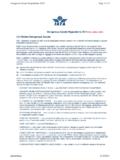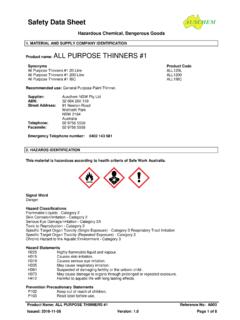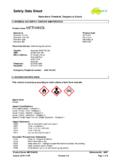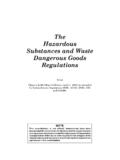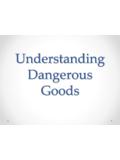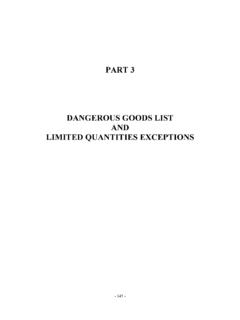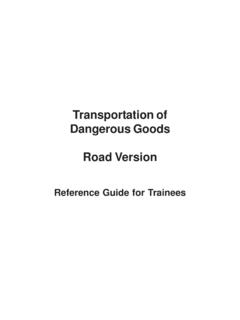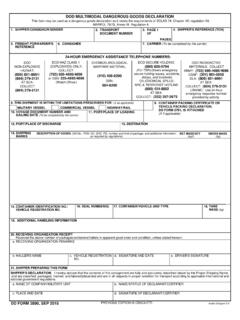Transcription of DANGEROUS GOODS CLASSIFICATIONS
1 DANGEROUS GOODS CLASSIFICATIONS . The Transport Of DANGEROUS GOODS And Marine Pollutants In Sea-Going Ships Is Regulated In The International Convention For The Safety Of The Life At Sea (SOLAS) And The International Convention For The Prevention Of Pollution From Ships (MARPOL). Terms Of Both (SOLAS) And (MARPOL) Have Been Worked Out In Detail And Are Included In The International Maritime DANGEROUS GOODS (IMDG) Codes. Air Transport Is Regulated By The International Civil Aviation Organization (ICAO) And The International Air Transport Association (IATA) At The Trade Level. Sea Transport Is Regulated By The International Maritime Organization (IMO). These Organizations Publish Codes Of Practice Based On The UN Recommendations Which Outline The Requirements For Safely Transporting DANGEROUS GOODS By Sea And Air. Imco Class Description Class 1 Explosives Division Substances And Articles, Which Have A Mass Explosion Hazard.
2 Division Substances And Articles Which Have A Projection Hazard But Not A Mass Explosion Hazard. Substances And Articles Which Have A Fire Hazard And Either A Minor Blast Hazard Or A Minor Division Projection Hazard Or Both, But Not A Mass Explosion Hazard. Division Substances And Articles, Which Present No Significant Hazard. Division Very Insensitive Substances Which Have Mass Explosion Hazard Division Extremely Insensitive Articles Which Do Not Have A Mass Explosion Hazard Examples Ammunition, Fireworks, Blasting Explosives. Class 2 Gases Compressed, Liquefied Or Dissolved Under Pressure. Division Flammable Gases Division Non-Flammable Gases. Division Toxic Gases Examples Division Cigarette Lighters, Refills For Gas Lighters, Acetylene, Ethylene, And Hydrogen Some Industry Use. Division Carbon Dioxide, Oxygen (For Medical And Industrial Use), Compressed Air, Freon Gas Used For Refrigeration And Air Conditioning, Compressed Nitrogen And Argon For Welding.
3 Also, Liquid Oxygen And Liquid Nitrogen For Industrial Use. Division Chlorine (For Water Treatment And Ammonia (For Industrial Works). Note Aerosols, As Pesticides, Air Fresheners, Aerosol Deodorants And Some Oven Cleaners Are Assigned To Division , Or Depending On Their Properties. Class 3 Flammable Liquids Division Low Flash-Point Group Of Liquids (Flash-Point Below 18C.). Intermediate Flash-Point Group Of Liquids Division (Flash-Point Of To But Not Include +23C.). Division High Flash-Point Group Of Liquids (Flash-Point Of +23C. Up To And Include +61C.). Examples Petrol, Kerosene, Paints, Car Lacquers, Chemical Solvents (Petroleum Derivatives), Varnishes. Class 4 Flammable Solids Or Substances Division Flammable Solids Division Substances Liable To Spontaneous Combustion Division Substances Which In Contact With Water Emit Flammable Gases.)
4 Examples Matches and Sulphur Powder. Division Calcium Carbide - Used To Produce Acetylene Gas. Class 5 Oxidizing Substances (Agents) And Organic Peroxides. Division Oxidizing Substances (Agents) Yielding Oxygen Increases The Risk And Intensity Of Fire. Division Organic Peroxides-Most Will Burn Rapidly And Are Sensitive To Impact Or Friction. Examples Division Pool Chlorine, Some Fertilizers. Class 6 Toxic And Infectious Substances Division Toxic Substances. Division Infectious Substances. Examples Division Some Pesticides, Industry Products Such As Cyanide Products. Division Waste Medical Products For Example. Class Class 7 Radioactive Substances Examples Substances Used In Industrial, Medical Or Scientific Purposes. Class 8 Corrosives Acids As Glacial Acetic Acid, Hydrochloric, Sulphuric And Nitric Acid, Caustic Soda And Examples Caustic Potash Class 9 Miscellaneous DANGEROUS Substances And Articles.
5 A Wide Range Of Substances As Asbestos, Some Fertilizers And Environmentally Examples Hazardous Products. MHB Materials Hazardous Only In Bulk. Packing Group Classes 3, 4, , And 8 Have Been Divided Into Three Packing Groups (PG): I, II Or III. The Packing Group Indicates The Degree Of Risk Within The Classes And Specifies The Standard Of Packaging. Packing Group I Denotes High Risk And Therefore Requires The Highest Standard Of Packaging; II Denotes Medium Risk; And III Denotes Low Risk. The IMDG Code Uses The Term Packaging Group Rather Than Packing G. IMCO TERMS. Imco Class Grouping Of DANGEROUS GOODS By Type Of Risk Involved, This Grouping Was Drawn Up By The UN Committee Of Experts On Transport. Corrosive Material A Liquid Or Solid That Causes Visible Destruction Or Irreversible Damage To Human Skin Tissue On Contact. Also, It May Be A Liquid That Has A Severe Corrosion Rate On Steel.
6 Flash Point The Minimum Temperature At Which The Flammable Vapors Of A Substance (In Contact With A Spark Or Flame). Will Ignite. UN Number United Nations Serial Number, That Is To Say, One Of The Four Digit Numbers Devised By The United Nations And Specified In The Approved Carriage List As A Means Of Identification For DANGEROUS GOODS . ADR. Means The European Agreement Concerning The International Carriage Of DANGEROUS GOODS By Road Signed At Geneva On 30th September 1957[4], As Revised Or Re-Issued From Time To Time MFAG. Medical First Aid Guide. MHB. Materials Hazardous Only In Bulk, Where Hazardous Regulations Are Not Applied To These Materials When They Are Carried In Closed Containers.
